Made Men
Made Men
Mafia Culture and the Power of
Symbols, Rituals, and Myth
Antonio Nicaso and Marcel Danesi
ROWMAN & LITTLEFIELD PUBLISHERS, INC.
Lanham Boulder New York Toronto Plymouth, UK
Published by Rowman & Littlefield Publishers, Inc.
A wholly owned subsidiary of The Rowman & Littlefield Publishing Group, Inc.
4501 Forbes Boulevard, Suite 200, Lanham, Maryland 20706
www.rowman.com
10 Thornbury Road, Plymouth PL6 7PP, United Kingdom
Copyright 2013 by Rowman & Littlefield Publishers, Inc.
All rights reserved. No part of this book may be reproduced in any form or by any electronic or mechanical means, including information storage and retrieval systems, without written permission from the publisher, except by a reviewer who may quote passages in a review.
British Library Cataloguing in Publication Information Available
Library of Congress Cataloging-in-Publication Data
Nicaso, Antonio.
Mafia culture and the power of symbols, rituals, and myth / Antonio Nicaso and Marcel Danesi.
pages cm
Includes bibliographical references and index.
ISBN 978-1-4422-2226-7 (cloth : alk. paper)ISBN 978-1-4422-2227-4 (electronic)
1. Mafia. 2. Organized crime. I. Danesi, Marcel, 1964- II. Title.
HV6441.N534 2013
364.106dc23
2013006239
 TM The paper used in this publication meets the minimum requirements of American National Standard for Information Sciences Permanence of Paper for Printed Library Materials, ANSI/NISO Z39.48-1992.
TM The paper used in this publication meets the minimum requirements of American National Standard for Information Sciences Permanence of Paper for Printed Library Materials, ANSI/NISO Z39.48-1992.
Printed in the United States of America
Chapter 6
Myth
Myth is the hidden part of every story, the buried part, the region that is still unexplored because there are as yet no words to enable us to get there. Myth is nourished by silence as well as by words.
Italo Calvino (19231985)
The German philosopher Ernst Cassirer characterizes human beings as symbolic animals. The initial symbols of a culture are connected to its founding myths, that is, to the stories that people tell about themselveshow they originated, why they exist, and so on. These allow humans to share group experiences in spiritual and thus meaningful ways. All cultures have them. So, too, do criminal societies. Without them, their symbols and rituals would make little sense, since they would not be able to link themselves to historical events and thus claim authenticity.
The movies have also joined in by embellishing and fictionalizing Mafia history. In The Godfather, Part II, the origins of the Mafia are traced back to Sicily, and the organization is portrayed as a timeless and mythical society. Michael Corleones wife, Kay, makes reference to the Mob as a Sicilian thing thats been going on for 2,000 years, and whose origin is shrouded in mystery. Similarly, the film The Yakuza opens with a blurb explaining that the Yakuza have been around for more than 350 years. Criminal organizations that have emerged in modern times, like the Russian Mafiya, and in specific situations (for example, in a prison or on the streets of an urban center), will invent convenient legends for themselves, which can be called simply street myths. One such myth is presented in Eastern Promises, as we have seen. It does not come from a claim to a mythic past, but inheres simply in the need to reject ones previous life through a ceremony of rejection.
Foundation Myths
Foundation myths are stories that are told in early cultures to explain how the world, people, and significant events came into existence. They revolve around divine personages, legendary heroes, or supernatural events. Later societies also have hero myths that attribute exceptional qualities to real historical figures. Robin Hood was a mythic hero who stole from the rich to give to the poor; William Tell was a crossbow hero who resisted tyranny; Davy Crockett was a frontiersman and congressman who died bravely in the battle of the Alamo in 1836. Britain, Switzerland, and the United States have made these heroes, and their stories, part of the foundational fabric of their nationhood.
Criminal societies like to tell stories that trace their origins mythically, imparting a sense of validity and legitimacy to themselves. As George Orwell so aptly puts it, Myths [that] are believed in tend to become real. But, as we have discussed, this is fiction that, like any good fictional story, is partly based on truth, partly on fantasy and on rationalization. The reality is different. It is guns and death, money and power. More often than not, the results are tragic, not only for the hapless victims, but for the criminals themselves. The Godfather, Part III ends with an attempt on Michael Corleones life, but a bullet misses him and tragically kills his daughter, an innocent bystander. An episode of the series The Sopranos unfolds in slow motion, as Tonys biological family is having dinner. This makes us feel that every person who enters the restaurant thus becomes a potential assassin, coming to kill Tony and his family.
Crime in Sicily was primarily a product of its feudal system. The absentee noblemen needed strong men with local power and influence, who also did not have much respect for the law, to manage their estates. Thugs were hired as the noblemens personal guardiani (guardians). Law officials were negligent and lenient and court proceedings lax and byzantine. Many judges bought their posts; clerks were paid little or nothing. Having no faith in the authorities, people looked to other means of protection. Banditry established itself early on as a protection business. By the nineteenth century, it started spreading to many areas of Sicilian society. During the rebellion of 1848 against Sicilys Bourbon rulers, the bandits once again opportunistically joined the uprising, allying themselves to the Italian patriot Giuseppe Garibaldi when he arrived to initiate the unification of Italy in 1860. As a consequence, the Mafia gained legitimacy and power, as the first campaigns against it after unification tried to establish the Piedmontese government as the sole authority over the countryside. But, as in the past, the authorities fell prey to corruption. The fighters for unity had seen the organization as an ally, but those they put in power were as corrupt as the ones they replaced. As Paul Lunde notes, it was the traditional Sicilian suspicion of state institutions that created the conditions in which the Mafia could develop. Nothing has changed since then.
It was from the culture of the gabellotti (the mediators between landowners and peasants) that the Mafia most likely arose. During the Battle of Calatafimi in 1860, the gabellotti joined forces with Garibaldis troops to form squadrons. The squadrons were called squadre della mafia, after unification, having become vigilante police forces fighting random bandit gangs that surfaced after unification. As such, they eliminated both the bands and became a silent partner in Sicilian politics, as Lunde explains in the following:
The Sicilian Mafia, now organized, offered to police the island and save the government the embarrassment of sending in troops. The government agreed, and some of the more prominent non-Mafia affiliated bandits were arrested or killed. Once again, the Mafia had positioned itself between two opposing groups and profited from the relationship with both.
To entrench its legitimacy in the new Sicily, the Mafia developed its code of omert, tapping into the deep-rooted Sicilian belief in a potere occulto (hidden power) that would challenge visible authority. In a society that was becoming more and more middle class, and thus bourgeois in its value system, the claim to chivalry and values stood out conspicuously and effectively. As the world began to change in the process of urbanization, and traditional values started to disintegrate, the Mafia, and other criminal organizations, sprung up like oases in a valueless barren social desert. No matter what their ultimate aim, one could at the very least empathize with them on a moral level. In this case, the means were seen to justify the ends. Myths about Mafia origins show this perfectly.
Next page
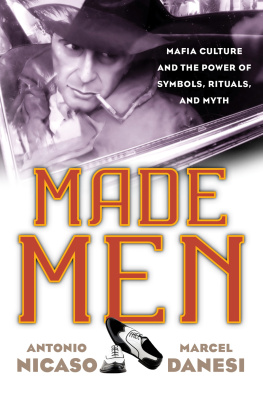

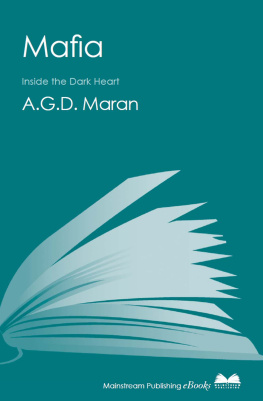

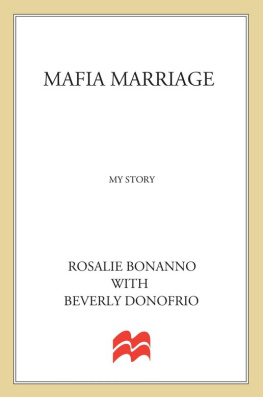

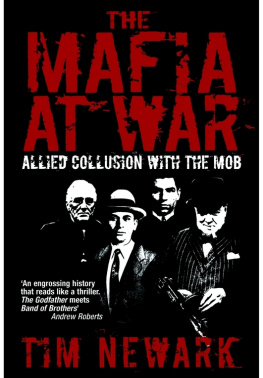



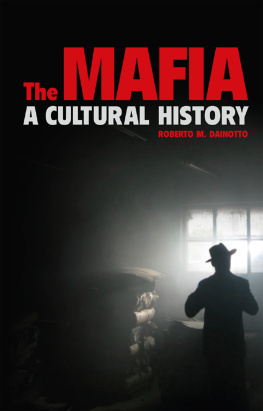
 TM The paper used in this publication meets the minimum requirements of American National Standard for Information Sciences Permanence of Paper for Printed Library Materials, ANSI/NISO Z39.48-1992.
TM The paper used in this publication meets the minimum requirements of American National Standard for Information Sciences Permanence of Paper for Printed Library Materials, ANSI/NISO Z39.48-1992.